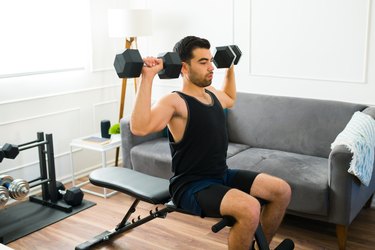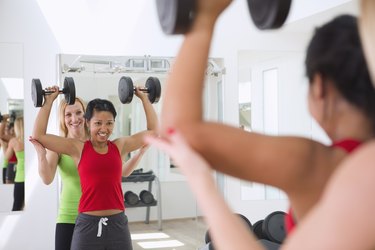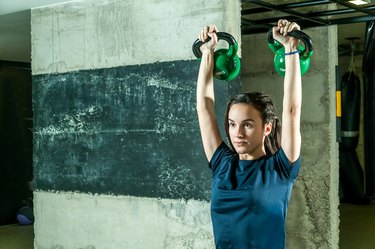
There are a ton of upper-body exercises out there, so it can be hard to figure out which ones give you the most bang for your buck. But if one thing's for sure, you can't go wrong with the shoulder press.
While the main muscle group this exercise works is your shoulders, it also targets many other areas of your upper body. Here's a look at exactly which muscles the shoulder press works, plus how to do it and its benefits.
Video of the Day
Muscles Used in the Shoulder Press
When you're performing the shoulder press, you're using far more than the muscles in your shoulder to execute the lift, but those are the main movers involved. You also get help from your chest and arm muscles, not to mention the muscles of your core that contract to stabilize you when you are lifting.
Here are the main muscles worked when doing the shoulder press.
1. Anterior Deltoid
The deltoid muscles at the top of your shoulders are one of the prime movers in the shoulder press.
The deltoid has three parts, according to the Cleveland Clinic: the anterior deltoid at the front, the lateral deltoid along the outside of your shoulder and the posterior deltoid on the back of your shoulder. The function of the deltoid as a whole is to raise the arm overhead.
During the shoulder press, your anterior deltoid is the most active part of this muscle group, according to Surrey Physio, a physiotherapy clinic based in Surrey, England.
2. Triceps
The triceps are the large muscles on the back of your upper arm. Although your triceps cross both your shoulder and elbow joints, these strong muscles help straighten your elbow joint during the shoulder press, according to Airrosti Rehab Center
To target the triceps even more, perform a close-grip shoulder press. The closer your hands are to each other, the greater the activation of your triceps.
3. Trapezius
Your upper back helps stabilize your shoulders during the shoulder press. The trapezius is a large muscle that spans from the base of your skull to the middle of your back and across the top of your shoulders, according to the Cleveland Clinic. It has three parts: the upper, middle and lower traps.
During the shoulder press, the middle and lower trapezius muscles assist with rotation of your shoulder blades as your arms reach overhead.
4. Stabilizer Muscles
Many muscles do little more than maintain proper positioning during the shoulder press, but are critical.
Your internal and external shoulder rotators are both working to keep your shoulder joint stable, per the Cleveland Clinic. Plus, your abdominals and lower back contract to maintain your torso in an erect position, according to the American Council on Exercise (ACE).
How to Do the Shoulder Press With Proper Form
To effectively target the muscles used in the shoulder press, be sure to use correct form. If you're new to this exercise, start with no weight or very light weights until you feel comfortable with the movement, according to the International Sports Sciences Association (ISSA).
- Sit on a bench with your feet rooted in the ground, holding a dumbbell in each hand.
- Bend your elbows and raise your hands to shoulder-height.
- Rotate your forearms until your palms face forward.
- Brace your core.
- On an exhale, press both dumbbells up overhead and in toward each other until your elbows are straight.
- Lower the weights back to the starting position with control.
Benefits of the Shoulder Press
Adding the shoulder press into your workout routine has a ton of advantages. Aside from strengthening the muscles in your upper body, this exercise improves your shoulders' flexibility and range of motion, which can ultimately help prevent injuries in this area, per the American Sports and Fitness Association (ASFA).
What's more, doing shoulder presses regularly can improve your posture and prevent back pain, according to the ASFA. That's because this move targets the upper back muscles that support your posture and properly align your spine.
Last, the shoulder press can help reduce strain and tension in your neck. Your shoulders support your neck, helping to hold your head up, per the ASFA. Strengthening this muscle group helps "hold your head higher with less effort from your muscles and tendons in the neck area," according to the ASFA, therefore reducing any potential strain and tension.
- ISSA: "9 Shoulder Press Variations to Shred Your Upper Body"
- Cleveland Clinic: "Deltoid Muscles"
- Surrey Physio: "Top 5 Deltoid Strengthening Exercises"
- Airrosti Rehab Center: "BICEP/TRICEP TENDONITIS: CAUSES, SYMPTOMS AND TREATMENT"
- Cleveland Clinic: "Trapezius Muscle"
- Cleveland Clinic: "Rotator Cuff"
- ACE: "Seated Overhead Press"
- ASFA: "Tone Your Shoulders: The Top 10 Benefits of Shoulder Presses"


